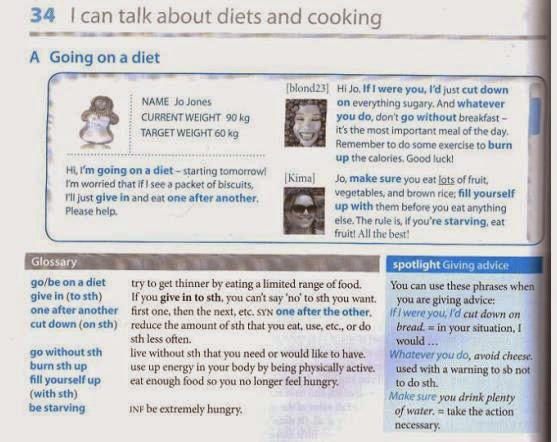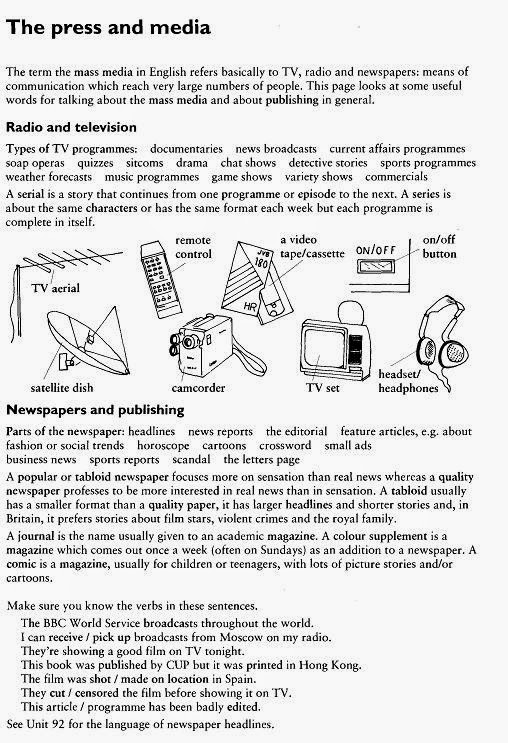Dear students!
In this post, you will find resources for the topic "
Health issues. Eating
habits. Healthy lifestyle."
Traditionally, we begin with the vocabulary load:
Food contents:
Protein
Mineral
Vitamin
(un/saturated)
fats
Carbs (carbohydrates)
Sodium
Calcium
Fibre
Nutrient
Nutrition
Nutritious
Nutritional
value/content
Additive
Calorie
cholesterol
diet/products
high in fibre/protein etc.
Food-related
concepts:
diet (n)
go on a
diet
fast (v)
metabolism
longevity
Types of
food:
dairy foods
grains
herbs
poultry
shellfish
veggies
fast foods
starchy foods
Disorders and their causes:
heart disease
heart attacks
overeating
sedentary lifestyle
weight loss/gain
blood pressure
obese
obesity
overweight
eating disorder
TYPES OF
EXERCISE:
calf-raise
chin-up
crunch
dip
flutter
lunge
push-up
sit-up
squat
star jump
jogging
take up exercise
Exercise-related concepts:
muscles
work out
commitment
dedication
determination
discipline
endurance
fitness
persistence
resolution
Take a look at some of these words in the table with definitions and sample sentences:
http://www.ieltsbuddy.com/health-vocabulary.html
For better understanding and further practice, check out these exercises:
Now we're getting closer to your blog task. Before you gather your ideas, read the article below and observe the usage of active vocabulary in context. If you come across collocations that you like or that seem interesting to you, we suppose you know what to do.
A balanced diet
Despite what you see in some diet books and TV programmes, healthy
eating can be really straightforward.
A diet based on starchy foods such as potatoes, bread, rice
and pasta; with plenty of fruit and vegetables; some protein-rich foods such as
meat, fish and lentils; some milk and dairy foods; and not too much fat,
salt or sugar, will give you all the nutrients you need.
When it comes to a healthy diet, balance is the key to getting it right.
This means eating a wide variety of foods in the right proportions,
and consuming the right amount of food and drink to achieve and maintain a
healthy body weight.
Most adults in England
are overweight or obese. That means many of us are eating more than we
need, and should eat less. And it's not just food: some drinks can also be high
in calories. Most adults need to eat and drink fewer calories in order to lose
weight, even if they already eat a balanced diet.
Food groups in
our diet
The eatwell plate shows that to have a healthy, balanced diet, people
should try to eat:
- plenty of fruit and vegetables
- plenty of starchy foods, such as bread, rice, potatoes and
pasta
- some meat, fish, eggs, beans and other non-dairy sources of protein
- some milk and dairy foods
- just a small amount of food and drinks that are high in fat and/or
sugar
Try to choose a variety of different foods from the four main food
groups.
Most people in the UK eat
and drink too many calories, too much fat, sugar and salt, and not enough
fruit, vegetables, oily fish and fibre.
It's important to have some fat in your diet, but you don't need to eat
any foods from the "foods and drinks high in fat and/or sugar" group
as part of a healthy diet.
Fruit and
vegetables: are you getting your 5
a day?
Fruit and vegetables are a vital source of vitamins and minerals.
It's advised that we eat at least five portions of a variety of fruit and
vegetables each day.
There's evidence that people who eat at least five portions a
day have a lower risk of heart disease, stroke and some cancers.
What's more, eating five portions is not as hard as it sounds.
Just one apple, banana, pear or similar-sized fruit is one portion. A slice of
pineapple or melon is one portion. Three heaped tablespoons of vegetables is
another portion.
Having a sliced banana with your morning cereal is a quick way to
get one portion. Swap your mid-morning biscuit for a tangerine, and add a
side salad to your lunch. Have a portion of vegetables with dinner,
and snack on dried fruit in the evening to reach your five a
day.
Starchy foods
in your diet
Starchy foods should make up around one third of everything we eat. This
means we should base our meals on these foods.
Potatoes are an excellent choice and a great source of fibre. Leave the
skins on where possible to keep in more of the fibre and vitamins. For example,
when having boiled potatoes or a jacket potato, eat the skin too.
Try to choose wholegrain or wholemeal varieties of starchy foods,
such as brown rice, wholewheat pasta and brown, wholemeal or higher fibre
white bread. They contain more fibre (often referred to as
"roughage"), and usually more vitamins and minerals than white
varieties.
Meat, fish,
eggs and beans: all good sources of protein
These foods are all good sources of protein, which is essential for the
body to grow and repair itself. They are also good sources of a range of
vitamins and minerals.
Meat is a good source of protein, vitamins and minerals, including iron,
zinc and B vitamins. It is also one of the main sources of vitamin B12.
Try to eat lean cuts of meat and skinless poultry whenever possible to cut down
on fat. Always cook meat thoroughly.
Fish is another important source of protein, and contains many
vitamins and minerals. Oily fish is particularly rich in omega-3 fatty acids.
Aim for at least two portions of fish a
week, including one portion of
oily fish. You can choose from fresh, frozen or canned, but remember that
canned and smoked fish can often be high in salt.
Eggs and pulses (including beans, nuts and seeds) are also great
sources of protein. Nuts are high in fibre and a good alternative to
snacks high in saturated fat, but they do still contain high levels of fat, so
eat them in moderation.
Milk and dairy
foods: avoid full fat varieties
Milk and dairy foods such as cheese and yoghurt are good sources of
protein. They also contain calcium, which helps keep your bones
healthy.
To enjoy the health benefits of dairy without eating too much fat, use
semi-skimmed, 1% fat or skimmed milk, as well as lower-fat hard cheeses or
cottage cheese, and lower-fat yoghurt.
Eat less fat
and sugar
Most people in the UK
eat too much fat and sugar.
Fats and sugar are both sources of energy for the body, but
when we eat too much of them we consume more energy than we burn,
and this can mean that we put on weight. This can lead to
obesity, which increases our risk of type 2 diabetes, certain cancers, heart
disease and stroke.
But did you know that there are different types of fat?
Saturated fat is found in foods such as cheese, sausages, butter, cakes,
biscuits and pies. Most people in the UK eat too much saturated fat,
which can raise our cholesterol, putting us at increased risk of heart disease.
Unsaturated fats, on the other hand, can help to lower cholesterol and
provide us with the essential fatty acids needed to help us stay healthy.
Oily fish, nuts and seeds, avocados, olive oils and vegetable oils are sources
of unsaturated fat.
Try to cut down on foods that are high in saturated fat and have smaller
amounts of foods that are rich in unsaturated fat instead. For a healthy
choice, use just a small amount of vegetable oil or reduced fat spread instead
of butter, lard or ghee. When having meat, choose lean cuts and cut off any
visible fat.
Sugar occurs naturally in foods such as fruit and milk, but we don't
need to cut down on these types of foods. Sugar is also added to lots of foods
and drinks such as sugary fizzy drinks, cakes, biscuits, chocolate,
pastries, ice cream and jam. It's also contained in some ready-made
savoury foods such as pasta sauces and baked beans.
Most of us need to cut down on foods high in added sugars. Instead of a
fizzy drink, for example, try sparkling water. Have a currant bun as a
snack instead of a pastry.
The task for the blog:
Think about your lifestyle as a student in terms of eating habits, physical activity and other health-related components and compare it to that of your peers. Do you think students maintain healthy lifestyle? What would you recommend them and yourself in order to stay fit and healthy? Present your answers in a brochure "Students' Healthy Lifestyle Guide" (or any other name you can think of). Include different aspects like bad habits, shopping habits, diet etc. Create your brochure using this tool:
http://www.readwritethink.org/files/resources/interactives/Printing_Press/
Requirements to the text are the same: 200-250 words, 20-25 active expressions.
A rough example:
Good luck!



















































